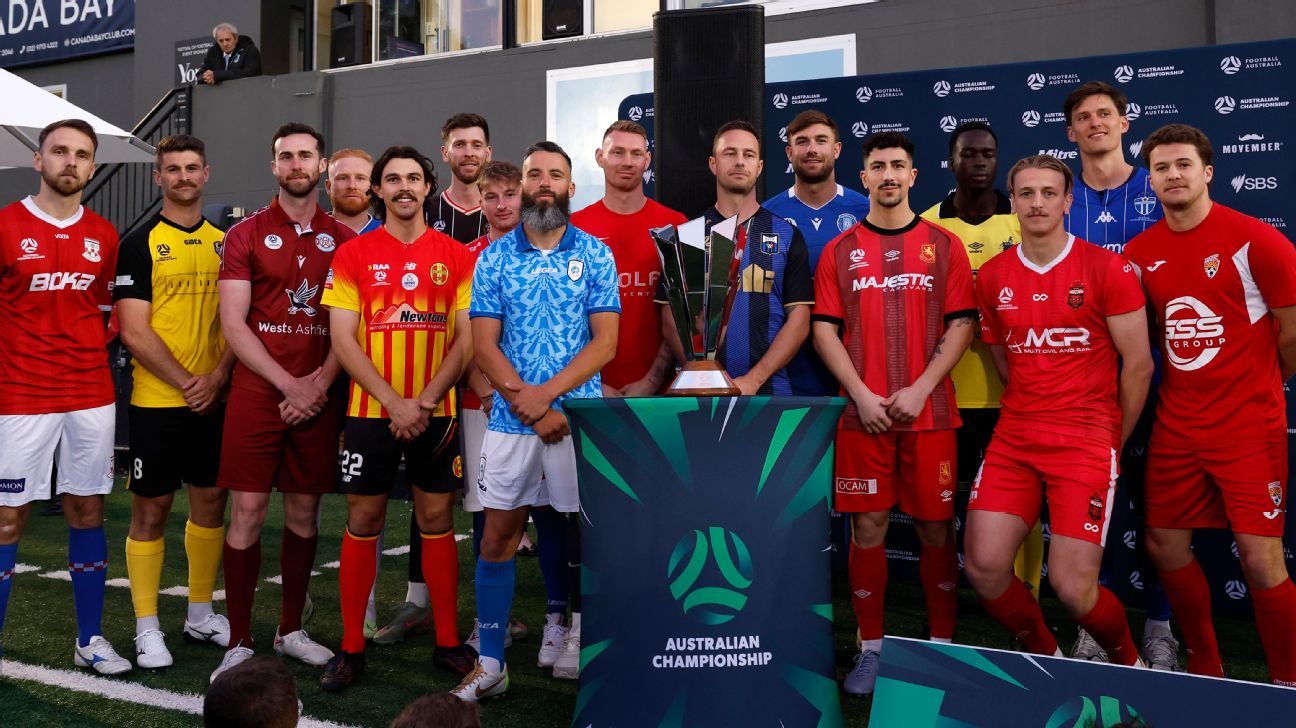Aspiration sits at the heart of The Championship, Australian football’s new men’s second-tier competition.
If you’ve been paying attention, you’ll have noticed it’s been a major theme pushed by those at Football Australia, spruiking their new entity as one that will serve as both a destination and pathway, not just empowering players and clubs outside the A-League Men, but going beyond to capture an untapped collection of hearts and minds and uplift a generation of coaches, support staff, administrators, media, sponsors, social media influencers, and everyone else in Australian football.
But the theme of aspiration goes far beyond the carefully constructed messaging of the federation. Because aspiration also helps tell the story of the Championship’s past, its present, and its future. It’s a defining theme of the decades of work to realise this moment, with those at the forefront often the subject of extreme pessimism, if not outright derision. It’s why the introduction of a new, nationwide stage for Australian football represents such an important moment for the game, at what is a challenging moment in its history. And it’s the presence of aspiration — or its absence — that will play a key role in The Championship’s ability to establish and sustain itself, or prove telling if it is to be consigned to the dustbin of history alongside dozens of other attempted reforms that, collectively, almost define Australian football’s history.
– Australian Championship: Clubs, season start, all you need to know
– Lynch: Milligan bringing pride back to the Newcastle Jets
– Disney+ the new home of Women’s Champions League in Australia
To start with, both literally and figuratively, when two former national champions in South Melbourne and Sydney Olympic kick off in the first-ever Championship game at Lakeside Stadium on Friday evening, it will not only mark the celebrated return of two historical Australian champions to a national stage but also represent a real, tangible step towards the dream of the introduction of a true national second division and the uniting of Australia’s pyramid along principles of sporting merit. These ideas have existed in some form or another for almost as long as there has existed a national first tier, be it the A-League Men or the National Soccer League before it, and now the Championship exists.
And while this new competition does not realise either vision just yet — operating with a “Champions League-style” format for the foreseeable future, there being no link with the A-League Men, and its participants drawn from a mixture of permanent “foundation sides” and premiers from the state federations’ National Premier League competitions — it still took a lot of work to get here. Thus, it’s important to not just recognise Football Australia, but also the individual champions, some of whom are not here to see it, and the collective bodies that have helped push for this moment; to pay credit to those who have worked, invariably unpaid and underappreciated, to help shift debate away from suppositions that a second tier was impossible to a point where it was not only acknowledged as possible but necessary.
Indeed, while cynicism and fatalism often surrounded their efforts, and continue to abound even as the competition gets underway (with good reason in some areas, it needs to be acknowledged), you’d struggle to find anyone in the game that would talk down what a successfully implemented second tier could provide on a conceptual level.
At a time when the value of providing opportunities to young players is being demonstrated by a wave of enforced austerity at the A-League Men level, a fully realised second division would provide hundreds more opportunities for young Australians to accumulate minutes at a higher level than previously offered. This, in turn, would put them in better standing to earn opportunities either domestically or overseas which would, in turn, strengthen Australian football: a rising tide on a far deeper talent pool lifts all boats, after all.
This same concept goes for clubs: consideration and investment required in staff, infrastructure, and community if clubs intend to compete on this new stage — strengthening the game by drawing closer to A-League Men sides above them while also providing incentive for those clubs below to raise their standards. Just look at the scenes surrounding Heidelberg United in the Australia Cup, where a club that had invested in itself was given reason to get excited about games with genuine stakes, and the community responded in kind.
Even in its current format, in which participatory clubs will continue to compete in their local National Premier League competitions, the Championship represents a building block. It’s a national platform, to be broadcast on free-to-air SBS, in which players can extend their seasons and meet a higher level of regular competition. In the wake of his side’s defeat to the Newcastle Jets in Saturday’s Australia Cup final, for instance, Bergers’ coach John Anastasiadis observed that the game was his side’s 40th of the season, with at least another six to come in the Championship, and that his players were getting a taste of professional football.
Admittedly, at a time when the A-League Men is struggling, questions have been asked as to the timing of the Championship’s introduction. But the obvious riposte is that the A-Leagues fought long and hard for independence, and that their subsequent moves to drive the car off a cliff once they got the keys shouldn’t mean they can now dictate to the rest of the game on reform.
Yet as accurate as this assessment is, one doesn’t need to get that confrontational to spruik what should, in fact, serve as a complementary offering to the top-flight beyond the benefits of an interconnected pyramid. Prefer the notion of soaking up the atmosphere with a kevapi and Canadian Club in hand on the terraces? Go to a Preston game at BT Connor Reserve. Want to catch a game in Australia’s best boutique stadium on a gorgeous summer day? Go to an Adelaide United game at Hindmarsh. It turns out, you don’t have to choose between the Sydney Derby and a Hellenic Derby. You can have both, and, when the game needs every match-going fan it can get, it could be argued you need to be offering just that.
Of course, a large asterisk on all of this is that many of the benefits that a second division would offer the game remain hypothetical because, as referenced, that’s not what the Championship in its current form is.
And therein lies the reason why aspiration will help to ultimately define what this new competition becomes. Because, right now, while it represents a positive step in the right direction, Football Australia — despite some self-backslapping — has not yet fully delivered on what it set out to do. We can say this with clarity because the federation itself declared its intentions to launch a standalone, fully home-and-away competition when it unveiled its eight foundation sides, only to dial back those plans in the months that followed.
Buy-in from fans will be crucial for the success of the Championship, but fans aren’t mugs. The novelty of a shiny new competition can’t last forever and what is essentially a postseason tournament in its current form almost certainly doesn’t have the juice to maintain the public and commercial interest that will allow it to be sustainable long-term. The lack of a clear pathway towards a standalone model is one of the main drivers of cynicism amongst those outside the A-Leagues, ostensibly your main target audience for this competition. A killjoy? Maybe. But it’s also what the On The Ball pioneers who will be oft-evoked in the weeks ahead would have observed without fear or favour.
Because ultimately, aspiration without bravery doesn’t get one very far. The launch of the Australian Championship represents a brave step and a historic day for Australian football. But it’s also a step in a larger journey.




